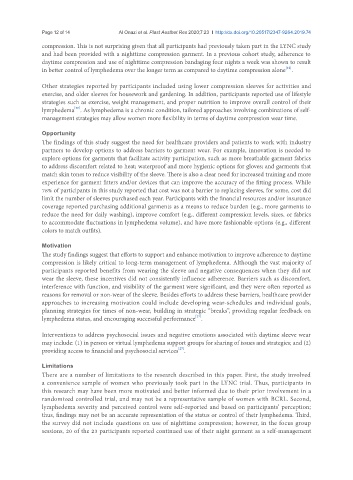Page 246 - Read Online
P. 246
Page 12 of 14 Al Onazi et al. Plast Aesthet Res 2020;7:23 I http://dx.doi.org/10.20517/2347-9264.2019.74
compression. This is not surprising given that all participants had previously taken part in the LYNC study
and had been provided with a nighttime compression garment. In a previous cohort study, adherence to
daytime compression and use of nighttime compression bandaging four nights a week was shown to result
[12]
in better control of lymphedema over the longer term as compared to daytime compression alone .
Other strategies reported by participants included using lower compression sleeves for activities and
exercise, and older sleeves for housework and gardening. In addition, participants reported use of lifestyle
strategies such as exercise, weight management, and proper nutrition to improve overall control of their
[26]
lymphedema . As lymphedema is a chronic condition, tailored approaches involving combinations of self-
management strategies may allow women more flexibility in terms of daytime compression wear time.
Opportunity
The findings of this study suggest the need for healthcare providers and patients to work with industry
partners to develop options to address barriers to garment wear. For example, innovation is needed to
explore options for garments that facilitate activity participation, such as more breathable garment fabrics
to address discomfort related to heat; waterproof and more hygienic options for gloves; and garments that
match skin tones to reduce visibility of the sleeve. There is also a clear need for increased training and more
experience for garment fitters and/or devices that can improve the accuracy of the fitting process. While
78% of participants in this study reported that cost was not a barrier to replacing sleeves, for some, cost did
limit the number of sleeves purchased each year. Participants with the financial resources and/or insurance
coverage reported purchasing additional garments as a means to reduce burden (e.g., more garments to
reduce the need for daily washing), improve comfort (e.g., different compression levels, sizes, or fabrics
to accommodate fluctuations in lymphedema volume), and have more fashionable options (e.g., different
colors to match outfits).
Motivation
The study findings suggest that efforts to support and enhance motivation to improve adherence to daytime
compression is likely critical to long-term management of lymphedema. Although the vast majority of
participants reported benefits from wearing the sleeve and negative consequences when they did not
wear the sleeve, these incentives did not consistently influence adherence. Barriers such as discomfort,
interference with function, and visibility of the garment were significant, and they were often reported as
reasons for removal or non-wear of the sleeve. Besides efforts to address these barriers, healthcare provider
approaches to increasing motivation could include developing wear-schedules and individual goals,
planning strategies for times of non-wear, building in strategic “breaks”, providing regular feedback on
[27]
lymphedema status, and encouraging successful performance .
Interventions to address psychosocial issues and negative emotions associated with daytime sleeve wear
may include: (1) in person or virtual lymphedema support groups for sharing of issues and strategies; and (2)
[27]
providing access to financial and psychosocial services .
Limitations
There are a number of limitations to the research described in this paper. First, the study involved
a convenience sample of women who previously took part in the LYNC trial. Thus, participants in
this research may have been more motivated and better informed due to their prior involvement in a
randomized controlled trial, and may not be a representative sample of women with BCRL. Second,
lymphedema severity and perceived control were self-reported and based on participants’ perception;
thus, findings may not be an accurate representation of the status or control of their lymphedema. Third,
the survey did not include questions on use of nighttime compression; however, in the focus group
sessions, 20 of the 23 participants reported continued use of their night garment as a self-management

